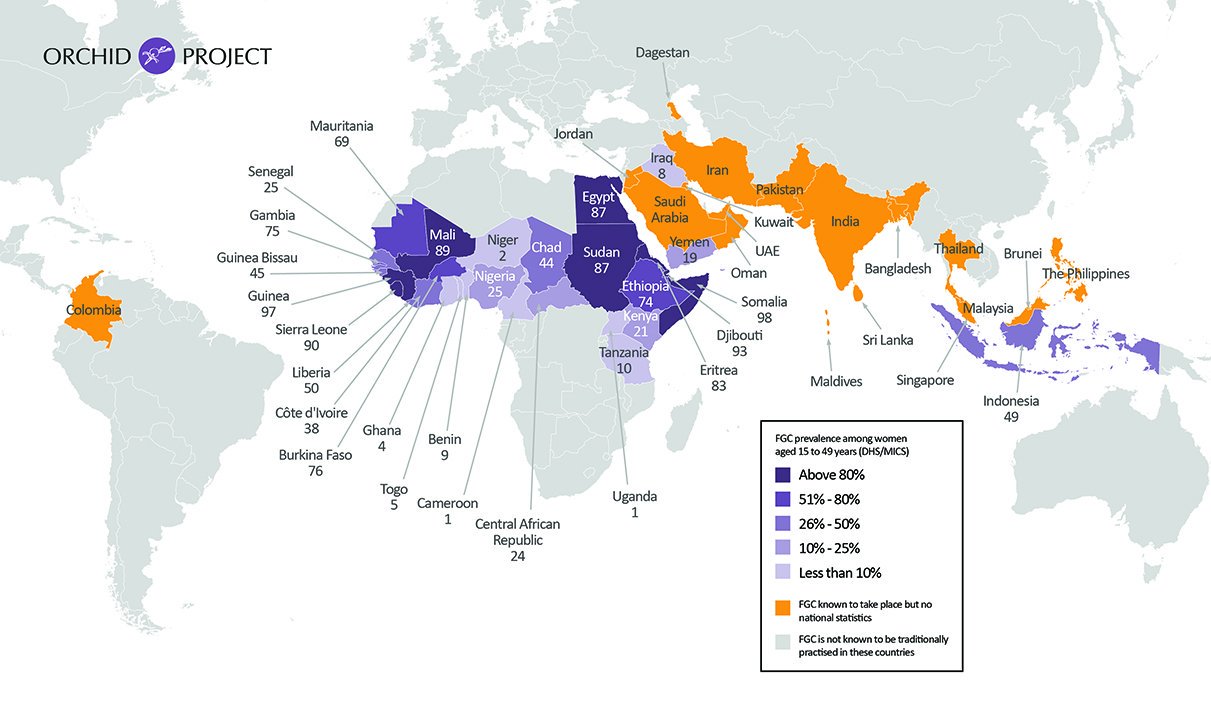By Brionna Wiggins
Upon hearing about female genital cutting and what it entails, it seems that one of the first facts you hear about it has to do with its prevalence in Africa and the Middle East. While it is true that these continents have a high prevalence (which has been decreasing according to a recent study by BMJ Global Health), it may contribute to the misconception that these are the only places in the world where females undergo FGC. Unfortunately, this is not the case. This practice reaches Asia, Europe, North America, South America, and Australia. Its presence on multiple continents leads FGC to be an international issue that needs to end with the support of all the nations involved.
![DOgkHoYWsAAwp8a[1]](/images/description/dogkhoywsaawp8a11.jpg)
As part of my senior project, I have been bestowed the opportunity to do volunteer work with Sahiyo. They work specifically with the Dawoodi Bohra community, whose members mainly reside in India, Pakistan, Yemen and East Africa. FGC is also prevalent in countries such as Malaysia and Indonesia. There have even been reports in Colombia, South America. This puts FGC on every continent in the world!
As previously mentioned, FGC occurs among diaspora communities. When families from countries that practice FGC move into new areas, they inevitably bring along the instilled need to continue the social norm. This leads to FGC being present in ‘receiving countries’, which can include places bordering practicing countries. Despite the handful of receiving countries that ban and criminalize FGC, the practice is still inflicted on girls in an effort to maintain their cultural identity. However, diaspora community members may send their daughters to their home country for ‘vacation cutting’. FGC is not a practice that is restricted by borders. Decades ago, FGC was practiced in some of the same countries that worked to prevent it.
In Victorian Era England, FGC ushered its way into the medical field as a cure for nervous diseases, masturbation, and any other infliction that doctors/surgeons related to the female organs. Gynecological surgeon Isaac Baker Brown popularized the idea of using clitoridectomy, or removal of the clitoris, as a solution for ailments in medical circles. After some time, Isaac Brown and those who followed this method were eventually condemned. Yet, it was not so readily removed from American medical textbooks. Doctors in the U.S. also continued with this treatment to cure female ailments and the last documentation of this practice dates as far back as 1947. It is the year Renee Bergstrom received a clitoridectomy at the age of three in “white, midwest America” (The Guardian). People with good intentions may harm others irreparably, even the ones who trust them the most.
While the practitioners may mean well, it still doesn’t excuse the continual physical and psychological harm of women and young girls. These mistakes have been made before, and are still being made by participating societies and people who perpetuate the practice. With FGC being so close to home, the problem cannot be ignored any longer as someone else’s problem. This practice affects women and girls on every continent. It must be dealt with using the full support of every global citizen to end the practice of FGC for the sake of women and men. You can help advocate against it too. Research is crucial in understanding a multifaceted issue such as this to ensure and reaffirm what you’re advocating for. That’s when you can volunteer your time or voice to organizations working to end FGC and keep up to date on the topic. Also, you can inquire about the laws in your state if they regulate or have anything in place pertaining to the practice. If there’s not a law already, then you can advocate for one being created.
More on Brionna:

Brionna is currently a high school senior in the District of Columbia. She likes drawing, helping others, and being able to contribute to great causes.

